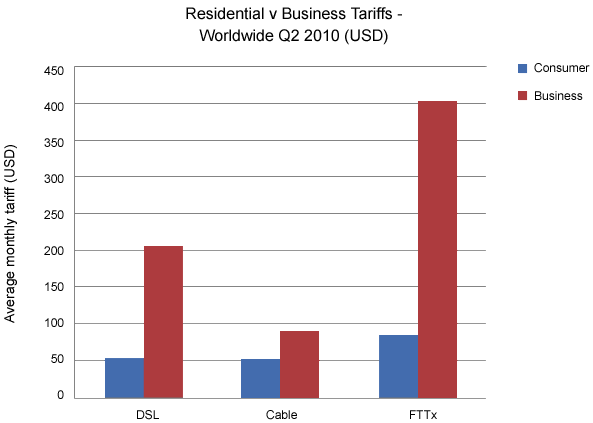

|
||
|
||
Analysis from Point Topic‘s recent reports on global broadband tariffs has revealed a significant gap in residential and business tariffs worldwide.
Tracking over 2000 tariffs on offer from ISPs around the world the latest quarterly figures show business are paying:
• 3.9 times as much for a DSL service as residential customers
• 1.8 times as much for a cable service
• 4.7 times as much for a fiber service

Clearly businesses are paying more for their services than residential consumers but the relative differences in the ratios is more marked than might be expected.
The first thought is that they are paying for more bandwidth and that is true to an extent. While the bandwidths advertised are often very similar and frequently less than those sold to households the major difference is the contention that is promised.
Businesses often require, or believe they require, an uncontended service where they don’t share their bandwidth with anyone else. Businesses need to know what they are getting and have confidence that they will continue to receive a specified bandwidth.
This is essentially impossible for cable services, which goes a long way to explaining the disparity in residential to corporate tariff ratio for that service set against DSL and FTTx. Cable just isn’t seen as a business grade service and carries the legacy of a long association with the provision of residential TV services.
That said the residential tariff for cable is no higher than a DSL service. A good explanation is the combination of competition particularly with DSL and more significantly the length of time the network has existed. In theory cable operators who own their networks have had enough time to recover the upfront implementation costs and can focus almost entirely on cheaper incremental upgrades to maintain a competitive edge.
With DSL and FTTx it is more straightforward to provide a dedicated service. The data however still poses the question why are business DSL services 3.9 times residential tariffs and business FTTx services 4.7 times more than residential counterparts?
We believe there are three primary reasons.
Firstly DSL is often a cheaper option, on a monthly basis, for smaller businesses who often balance concerns about consistent bandwidth against budget and are less concerned about the price per megabit. The tariffs are pitched at the lower end of the business market.
Secondly is that unless you are consistently maxing your bandwidth usage you won’t gain all the benefits of a high speed dedicated connection, so why pay for it? For SMEs in particular where utilisation is more likely to be less than 100% than in larger organisations it can make sense.
Thirdly FTTx has a lower price elasticity of demand. It is a newer perhaps sexier and relatively future proof service. ISPs can charge what the market will bear and are taking the opportunity while they can.
Business customers are paying close to what it actually costs to deliver the bandwidth available on their tariff. They are cross-subsidising the residential customer acquisition schemes of the ISPs.
The ratios are likely to decrease. Recent results shows ISPs in mature and stable markets are moving to increase their ARPU particularly for the residential sector. Whether this means price hikes for households or better value for money for businesses will become clearer over time.
Sponsored byIPv4.Global

Sponsored byDNIB.com

Sponsored byVerisign

Sponsored byRadix

Sponsored byVerisign

Sponsored byCSC

Sponsored byWhoisXML API
